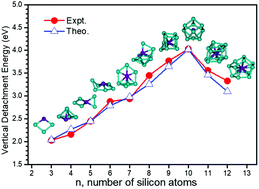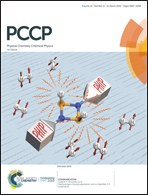Structural evolution and electronic properties of CoSin− (n = 3–12) clusters: mass-selected anion photoelectron spectroscopy and quantum chemistry calculations†
Abstract
The structural and electronic properties of cobalt-doped silicon clusters, CoSin− (n = 3–12), are investigated using mass-selected anion photoelectron spectroscopy combined with quantum chemistry calculations. The critical size from an exohedral to an endohedral structure of the anionic clusters is n = 9 and that of the neutral ones is n = 10. Natural population analysis shows transfer of electrons from the silicon framework to the Co atom. The total magnetic moments of CoSi3− and CoSi4− clusters are 2 μB, while those of CoSin− (n = 5–12) clusters are 0 μB. The experimental measurements show that CoSi10− has the highest vertical detachment energy among all the CoSin− (n = 3–12) clusters in the current study. The theoretical calculations show that CoSi10− has a C3v symmetrical tetracapped trigonal prism structure and very large HOMO–LUMO gap. Both experimental and theoretical results imply that CoSi10− has unusual stability. Its special stability is attributed to its highly symmetric structure and closed-shell molecular orbital configuration. The structure of neutral CoSi10 has relatively lower symmetry as compared to that of CoSi10− due to Jahn–Teller distortion.



 Please wait while we load your content...
Please wait while we load your content...